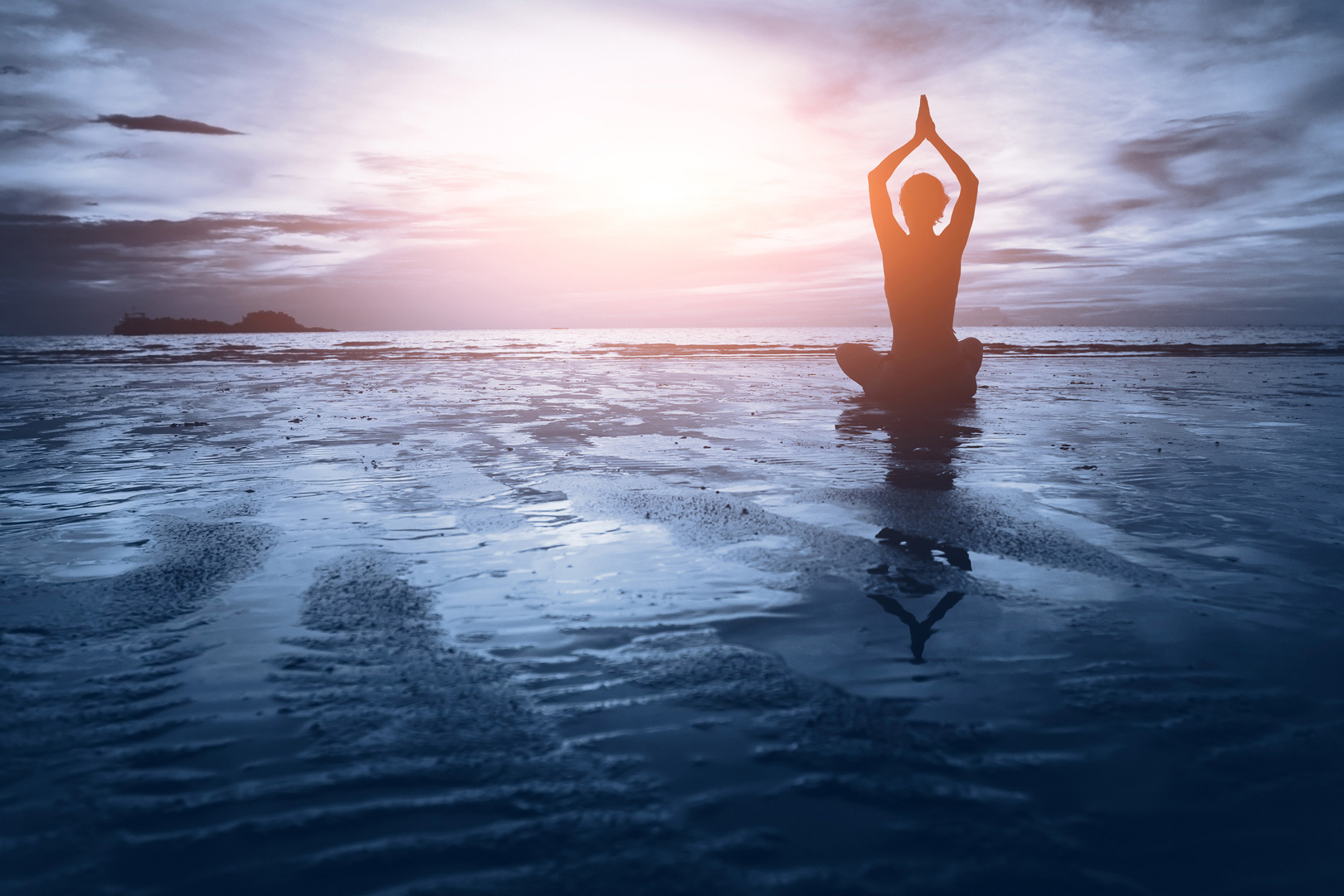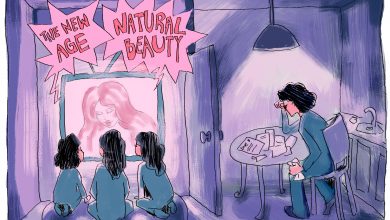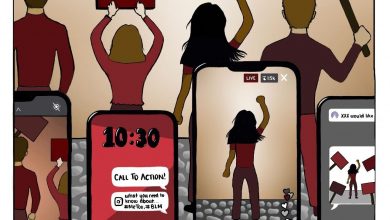Girlbossing Spirituality

Image Description: A person holding a tree pose while sitting down on a beach.
Growing up, when I got sick, my family would first turn to Ayurveda (pronounced ah-yoor-veh-dah), an ancient holistic medicine from South Asia. When I had a cough in first grade, Mama lovingly fed me shahad or kali mirch – honey with black pepper. Every time I caught a cold, she’d make me haldi ka doodh before I went to bed. I’d watch, entranced, as she’d slowly stir the vibrant turmeric into the milk, adding extra sugar for me because I disliked the taste. The summers my Nani visited, she’d do the same: caring for us with remedies she meticulously made in our kitchen from herbs she grew in our garden. The afternoons I’d come home with a headache, my Dad would light agarbatti (incense) to help me relax after giving me a Tylenol. When I visited India, my Bua, my dad’s sister, would bring me to her yoga studio. Within those walls was a sense of peace that I will always fondly remember. There, she’d teach me different asanas to alleviate the neck pain I got from peering down at my phone for too long. When I started experiencing anxiety in middle school, she would teach me different Pranayama breathing and meditation techniques. I grew up with Ayurveda and Yoga as part of my home because it was the way my family took care of each other.
My family’s collection of Ayurvedic knowledge was passed down through words – loving advice on how to treat that sore throat, cold, or cough. There is no book that our people go to, no written documentation of how many grams of what herb to use and when to use it. Instead, we spread this rich knowledge through relationships, care, and love. Mama doesn’t remember how many teaspoons of haldi to use in a cup of milk. She just remembers how her own mother lovingly fed her this same concoction to help with the same cold that afflicts her child now.
Because of the intimate way this knowledge is passed down, the way white women have acquired this knowledge of now-branded ‘wellness’ to such accuracy feels not only disrespectful, but invasive. Haldi ka doodh is now the golden milk latte mix sold on Amazon by Kirstens and Emilys without a trace of the brown parents that built this knowledge. Mama would always wonder, “How did they know about this?” It feels as though they snuck into our warm homes, deviously spied on a mama or grandma caring for her sick child or grandchild, and greedily repackaged these stolen sacred ailments as new discoveries.
Seeing white people abuse and profit off of my culture makes me feel like I’m trapped behind a soundproof one-way glass, helplessly watching as the sacred practices that my family nurtured me with are stolen and rebranded as a new, progressive wellness. I feel invisible, forced to look on as white followers of the wellness movement abuse my culture to heal themselves, basking in their ignorance and erasure of my people. While they work on their mental health by culturally appropriating spirituality, I feel like mine deteriorates.
When my mental health suffers, I try to go back to what my family taught me, part of which is the meditation Bua raised me with. But even when I look for yoga classes nearby or search for a quick meditation video online, all of the people at the forefront are white– white women wearing shirts that say “Namastay in bed” and “There’s no place like Om” paired with LuluLemon “yoga pants;” white women holding downward dog and tree poses in front of a waterfront at sunset; and the worst of all, white women sexualizing the practice.
White people have diluted my culture into a corrupted version that they can profit from. A 2015 study in the Journal of Behavioral Medicine found that racially, yoga in the US was consistently linked to whiteness. Yoga is seen as a practice made for and by upper-middle-class white women because white folks have gone to great lengths to strip the practice of its South Asian roots, which they view as dirty and demonic. When yoga was first introduced in the States by Hindi guru Swami Vivekananda in 1893, he was met with backlash. Only when white hippies repackaged the practice and other aspects of South Asian culture into their superficial “counter-culture” movement did yoga grow popular– that is, only one part of yoga. Out of the eight limbs, only hatha yoga made the cut. Because of its emphasis on asanas or poses, white hippies found that hatha yoga was the easiest to market and showcase to others, leading to the consumer culture around yoga today.
Despite widespread ignorance of the culture behind yoga, public bans on the practice have been enacted in many states over the past few decades, headed by white Republican outrage over its “barbaric” non-Christian origins. In May of 2021, a bill in Alabama lifted the 1993 ban on yoga in public schools but prohibited instructors from teaching the spiritual aspects of the practice, spreading awareness of its roots, or even just saying the Sanskrit names for asanas, which would now only be called “poses.” To get the bill passed, the Democratic legislator heading it argued that yoga was “just exercise.” Lifting the ban only to continue diluting yoga into its whitewashed, commercialized counterpart almost feels worse than just banning the practice altogether. Either way, white people will only consume yoga when its instruction erases the ancient traditions of South Asian people.
Once these practices are distanced from their roots, white folks deem them palatable enough to consume. They love to hear about exotic medicines and spiritual awakenings until they’re hearing it from a person of color, in turn allowing other white people to profit off of watered-down culture. In 2020, the yoga industry brought in $11.56 billion of revenue. Combined with clothing & equipment like yoga mats, that number reaches over $16 billion, nearly all of which goes into the pockets of white folks. The capitalist focus on increasing revenue detracts from the healing that the true practice centers around. Yoga has been commodified into slogans on t-shirts, trendy athletic wear, and stock prices.
This white ‘wellness’ is celebrated, but our people have been demonized for practicing Ayurveda and Yoga throughout the centuries of British colonization and exploitation of South Asia. The British called these ancient traditions primitive, with Winston Churchill calling us “a beastly people with a beastly religion.” For years the British had imposed bans on yoga in South Asia and forced many of us to convert to more ‘civilized’ religious practices like Christianity. Now, those same practices white people considered demonic have been repackaged for their benefit.
The pattern of white folks twisting South Asian culture into health and fitness doesn’t stop at Ayurveda and Yoga – it extends to holidays too. My favorite holiday from childhood to this day has been Holi, the South Asian festival of colors. During Holi, we run around and throw rung (color powder) at each other, dance, and play with water.
I love Holi because the first time I celebrated the festival was with my Dadaji, who was visiting from India. Despite doctor’s orders to avoid running, he patiently entertained my shenanigans, and we chased each other for hours with rung and water. We don’t get to see each other often so I look back on these memories when I miss him.
Now, my family often goes to organized Holi functions with my aunt and uncle, where we’d have huge color powder and water fights and even join in the organized flash mob Bollywood dances. After many hours of intense khel, my aunt would take us to her favorite dosa joint. Exhausted and covered in caked color, we’d dig into dosas, idlis, sambar, and more and top it off with a cup of chai. I cherish these memories. Holi is a time of play for everyone, adults and children alike.
I was describing Holi to my friend the other day, and she went, “Oh, like a color run!” Color Runs look exactly like the Holi my people celebrate: with the same color powder, water, and dancing, but with no mention of the festival.. and with the added bonus of a 5K. When I look at Color Runs, scattered with white faces, I feel my people are being erased once again– brown hands playfully throwing rung at each other wiped out and rewritten with white ones. Despite Holi having no connection to fitness, white folks have treated the festival as such. To them, it’s an exciting, exotic experience. To me, the festival is a reminder of the precious time I’ve spent with loved ones and the beauty of my culture.
From Holi to Yoga to Ayurveda and much more, the white folks profiting from our culture are often Girlbosses, white women whose “feminist” corporate exploits are rewarded as progress. Self-care brands and healing products veil white wellness SheEOs co-opting and commodifying South Asian and other POC cultures. Multi-million-dollar company Goop owned by Gwyneth Paltrow sells products like Mind & Body Wash, along with the typical Golden Latte Mix. And for 30 dollars, you can buy tiny 2-inch incense sticks – or as my Dad calls it, knock-off Agarbatti! Moon Juice, a twenty-million-dollar company also owned by a white woman, sells products like Magnesi-Om. Some aromatherapy companies even sell Chakra Soapstone Oil Diffusers. These white folks saturate their product names with all the spiritual buzz words they could think of without researching the South Asian religious connotations. No aspect of South Asian culture has escaped the greedy, roaming hands of white people.
While girlbosses are making huge profits, they’ve still turned a sacred way of healing into a profit machine, negating any healing for themselves and their followers. Capitalistic wellness contradicts the very premise of Ayurveda, and really, any form of healing. Your mental health can’t be liberated if your practice constantly involves posting yoga poses on social media and making sure the lighting’s okay to get the most likes. The consumer culture that has infected ‘wellness’ casts blame onto anyone struggling, reducing their health struggles into an accusation that they are not doing enough– whether that be not buying enough products, not attending enough classes, or not setting enough time in the workday to meditate. Capitalist wellness ignores the privilege necessary to meet those requirements and instead guilts those who don’t have the resources and time to do so.
This focus of Girlboss feminism on capitalist exploits hurts people of color further, beyond the exploitation of culture. In order to increase profits, these companies exploit the labor of women in South and Southeast Asian countries to drive down production costs. They’ll set up performative “Women Empowerment Abroad” programs while paying South Asian women measly wages for long hours to build the products that they also stole from South Asia. Not only have they appropriated South Asian culture, but they’ve also co-opted Mahayana Buddhist practices, Ojibwe religious traditions, Hoodoo spirituality, and so, so much more. The wellness industry hurts many, and if you’re an avid follower of the unethical mainstream, just keep in mind that your yoga mat is made with the blood, sweat, and tears of brown people. Every time you strike a ‘pose,’ think about who you’re trampling over.




